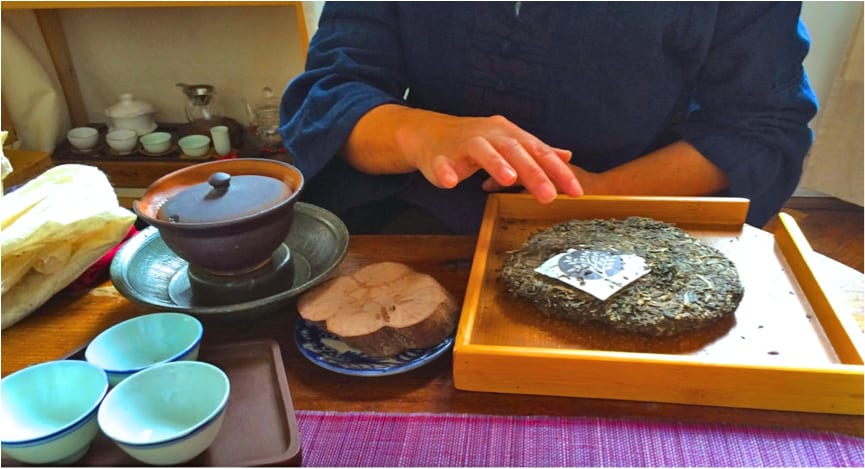
There’s nothing like a whiff of scandal to ensure popularity in perpetuity. Tea –that innocuous hot drink that reminds me of grandmothers, knitted cosies and scones – has had more than its fair share. Tea has sparked intrigue, attempted bans and even warfare. Tea has been described as dangerous liquid fire and better than sex. Nowadays more tea is drunk worldwide than any other beverage except water.
In my search to find out more about the world’s favourite drink, I have found Sabine Ripoll. This niçoise tea connoisseur knows more about Camellia sinensis infusions than anyone else on the French Riviera. She has sold tea to Alain Ducasse, tea-trained Michelin-starred restaurant teams and served tea to the Chinese government. Today she’s teaching me about tea during an hour-long tea ceremony…
[ihc-hide-content ihc_mb_type=”block” ihc_mb_who=”reg” ihc_mb_template=”” ]
SIGN IN TO YOUR PREMIUM ACCOUNT TO READ MORE
(click Sign In at the top of the page)
[/ihc-hide-content]
[ihc-hide-content ihc_mb_type=”show” ihc_mb_who=”reg” ihc_mb_template=”” ]
“Tea has vintages like wine. I tasted a tea from 1800 once,” says Ripoll, showing me her stash of decades-old tea. She delivers one bombshell after another about a drink that I thought I knew well. I’m starting to wonder whether the British dust-in-a-bag with added milk and sugar should even be regarded as the same drink.
Indeed our beloved cuppa of black tea is actually Chinese red tea. It seems that something was lost in translation during the 17th-century tea clipper shipments. Chinese tea colours range according to the fermentation process from white through yellow, green, blue (Oolong) and red to black tea (known as pu-erh tea by Westerners). Pu-erh tea is the Château Latour of the tea world and Ripoll’s specialisation. “Once you drink pu-erh tea,” she reasons, “you’ll never drink anything else.”
While most teas are drunk one to two years after harvest, pu-erh tea can be kept for decades. Prestige pu-erh tea is made into paper-wrapped, compressed-tea cakes. This preservation method started as a space-saving device for yearlong horseback voyages from Yunnan, a province in southwestern China, to Tibet. The compressed tea leaves lived and breathed through the paper during the journey as a combination of oxygen and microorganisms continued the post-fermentation. When the Chinese realised that the tea tasted even better post-voyage than before, tea vintages were born.
Nowadays vintage pu-erh tea fetches high prices at auction. A tong (seven cakes) of FuYuanChang pu-erh tea from the 1900s recently reached £1 million (€1,276,065). At just over £500 (€638) per gram, that would make a pot of tea around £4000 (€5,100).
Ripoll sources pu-erh tea from the Yunnan province where tea was first cultivated as a medicine. Tea trees dating several thousand years old and measuring over 20 metres in height bare little comparison to the small, clipped tea bushes designed for intensive cultivation elsewhere.
“You don’t have tea trees like that in India,” says Ripoll, opening a hand-painted box with a cake inside, accompanied by a photo of the 23-metre, 2,500-year-old tea tree (on a hillside terroir where deeper root systems yield better tea) that produced the leaves for the cake we are about to taste. She gouges out a handful of leaves before rinsing them several times in boiling water. The leaves are so strong that an infusion of mere seconds is enough and the same leaves can be reused for up to three hours.
No tea ceremony is the same. Each item for our tea ceremony has been chosen to suit my partner and me from the century-old teapot to the gurgling toad that soaks up the rinse water. Ripoll favours delicate 40-year-old, broad-rimmed teacups over their commercial impermeable-glazed, thin-brimmed counterparts. She insists, “Everything from the teacups to the teapot influences the taste.”
We pour our first cups in silence and make a wish. The smoothly nuanced hot liquid slips down my throat as I make my wish: to win the lottery so I can buy my own tong of vintage pu-erh tea.
Sabine Ripoll contact@sminhsen.fr, +33 6-27-12-00-98.
Le Teashop
This family-run establishment is Monaco’s best address for tea. With 130 single-estate tea references from China, Japan, India, Taiwan, you’re spoilt for choice. After relaxing over a pot of tea and cake, you can browse the shop for tea-related paraphernalia, from handcrafted mugs to tea strainers.
Le Continental, Place des Moulins, Monaco, leteashop.com, +377 97-77-47-47.
Article first published July 15, 2016.
[/ihc-hide-content]